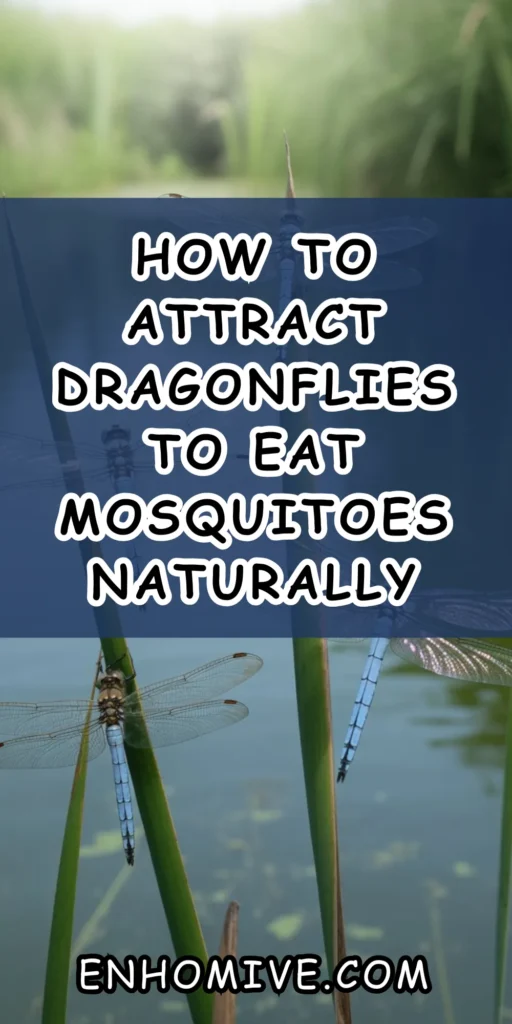How To Attract Dragonflies To Eat Mosquitoes Naturally
If you’re tired of mosquitoes ruining your summer evenings, it’s time to call in nature’s best pest control team — dragonflies. These beautiful, fast-flying insects are not just mesmerizing to watch; they’re also mosquito-eating machines. A single dragonfly can consume hundreds of mosquitoes a day, making them one of the most effective (and chemical-free) solutions for mosquito control.

Here’s how to turn your yard or garden into a dragonfly-friendly retreat that keeps mosquitoes away — naturally, beautifully, and on a budget.
Why Dragonflies Are the Perfect Mosquito Control
Dragonflies are natural predators that feast on mosquitoes both in their adult and larval stages. They hunt on the wing, zipping through the air to snatch mosquitoes mid-flight. Even their babies, called nymphs, eat mosquito larvae in ponds and water features.
Unlike chemical repellents or bug zappers, dragonflies don’t harm other beneficial insects — and they help maintain a balanced ecosystem in your backyard.
Step 1: Add a Small Water Source
Dragonflies need water to breed, so the first step is to create a mini pond or water feature. It doesn’t need to be big or fancy — even a 2×3-foot pond liner or large barrel can work.
Make sure your pond has:
- Shallow edges for easy landing
- Still or slow-moving water (dragonflies prefer calm surfaces)
- Rocks or sticks for perching
Avoid adding fish that eat dragonfly larvae, like koi or goldfish. Instead, let the pond stay as natural as possible — even algae and pond plants help attract them.
Step 2: Add Native Aquatic Plants
Dragonflies love ponds with vegetation where they can lay eggs and hide from predators. Try adding a mix of floating, submerged, and marginal plants such as:
- Water lilies – for shade and egg-laying spots
- Cattails or rushes – for nymph shelter
- Water milfoil – to give nymphs cover underwater
- Pickerelweed – attracts adult dragonflies to perch
A lush pond garden doesn’t just look beautiful — it creates the perfect nursery for mosquito-eating dragonflies.
Step 3: Create Sunny Open Spaces
Dragonflies are sun-lovers. They need warm areas to fly, mate, and hunt. Keep part of your garden open and sunny, with minimal tree cover or shade.
They also like to rest on tall stems, rocks, or garden stakes. Place a few decorative stakes or bamboo sticks near your water source to give them ideal perching spots.
Step 4: Avoid Pesticides and Chemicals
Even small amounts of lawn pesticides, mosquito sprays, or weed killers can harm dragonflies and their larvae. These chemicals contaminate water and kill the tiny insects that dragonflies feed on.
Instead, go natural:
- Use manual weeding instead of chemical sprays.
- Plant mosquito-repelling herbs like lavender, basil, and citronella near your patio.
- Let dragonflies do the mosquito control for you.
A pesticide-free yard invites more dragonflies — and keeps your ecosystem balanced.
Step 5: Add Rocks and Perch Spots
Dragonflies spend time basking in the sun to warm their wings. Add a few flat rocks, garden ornaments, or driftwood near your pond or open spaces.
These sunny perches help them rest between flights — and give you a front-row seat to watch them hunt mosquitoes.
Step 6: Keep Water Clean But Natural
You don’t need crystal-clear pond water. In fact, dragonflies prefer natural-looking, slightly murky ponds filled with small insects.
Clean debris occasionally, but avoid draining or scrubbing it too often. If mosquitoes start breeding before dragonflies arrive, add mosquito dunks (Bti tablets) — they kill mosquito larvae but are safe for dragonflies and other wildlife.
Step 7: Attract Other Insects Dragonflies Feed On
Dragonflies also eat gnats, flies, and midges. You can attract their food source by planting:
- Wildflowers (like coneflower, yarrow, and coreopsis)
- Native grasses
- Flowering herbs like dill, fennel, and mint
A diverse garden means a steady food supply — which keeps dragonflies coming back every season.
Cost Breakdown: Build Your Dragonfly Haven
| Item | Estimated Cost | Notes |
|---|---|---|
| Small pond liner | $20–$40 | You can use a barrel, tub, or shallow basin |
| Native pond plants | $10–$30 | Start with 2–3 varieties |
| Flat rocks & perches | Free–$15 | Use garden stones or branches |
| Mosquito dunks (Bti) | $10 (6-pack) | Safe for pets and dragonflies |
| Total DIY Setup | $40–$80 | Budget-friendly and long-lasting |
Once set up, maintenance is minimal — just check your pond weekly and enjoy the view.
Pro Tips for Success
- Patience pays off: It might take a few weeks to months for dragonflies to find your pond. Once they do, they’ll return year after year.
- Keep a mix of plant heights: Dragonflies like different levels for hunting and perching.
- Add movement nearby: A small fountain or dripping feature can help attract them without disturbing larvae.
- Pair with mosquito-repelling plants: Lavender, rosemary, and marigolds make a perfect combo around your pond area.
Quick Dragonfly Habitat Checklist
☐ Add a small pond or water feature
☐ Include floating and edge plants
☐ Keep part of the garden sunny and open
☐ Avoid fish and pesticides
☐ Add flat rocks and bamboo perches
☐ Use mosquito dunks (Bti) if needed
☐ Grow wildflowers and herbs nearby
Final Thought: Let Nature Handle the Mosquitoes
Inviting dragonflies into your yard is one of the simplest, most eco-friendly ways to control mosquitoes — no chemicals, no constant spraying, just natural balance.
With a little water, some native plants, and a sunny perch or two, you can enjoy peaceful summer nights where dragonflies do the hard work — and you simply enjoy the view.






